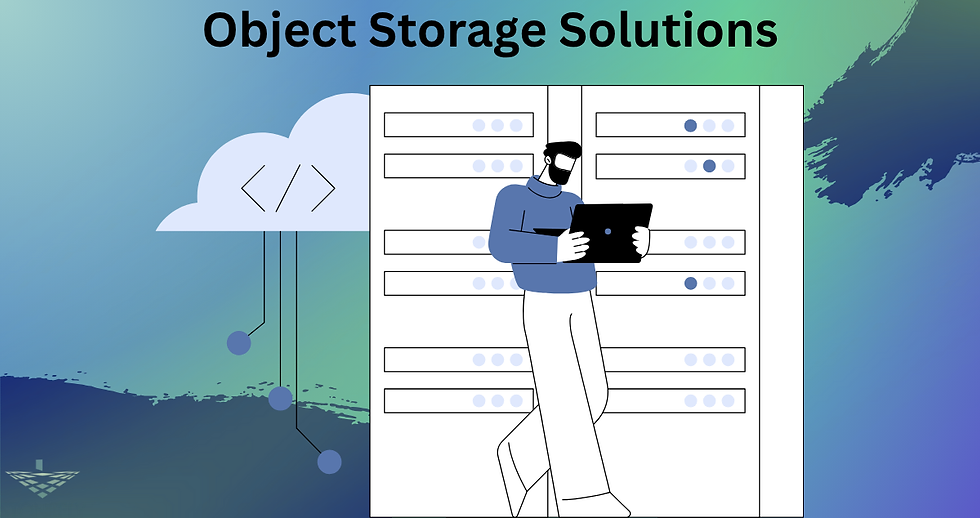High Availability: Why Enterprise Storage Systems Must Never Sleep
- finnjohn3344
- Aug 11
- 3 min read
In the fast-paced world of enterprise IT, downtime isn’t just inconvenient — it’s costly, risky, and damaging to reputation. That’s where Object Storage Solutions step in as a key player. Designed to meet high availability standards, these systems are purpose-built to ensure that your data is always within reach, even when hardware fails. With built-in redundancy, smart failover mechanisms, and distributed architecture, object storage not only keeps your data safe but also keeps it online.
Whether you're running mission-critical applications or managing terabytes of client records, you need a storage solution that doesn’t blink.
Let’s dive into how high availability works and why it’s crucial for business continuity.
Understanding High Availability in Enterprise Storage
High availability (HA) isn’t just a buzzword—it’s a system design philosophy aimed at minimizing downtime and maximizing uptime. In enterprise storage, HA means your system is always ready to serve data, regardless of failures in hardware or network paths.
At the heart of this strategy are redundant components. Think dual power supplies, mirrored disk arrays, and active-active controllers. These elements ensure that if one component fails, another instantly takes over without disrupting operations.

Redundancy: The Backbone of Uptime
Redundancy is the key to resilience. In enterprise storage systems, this includes:
Redundant Power Supplies: If one power source goes offline, a backup kicks in automatically.
RAID-Configured Disk Arrays: Data is spread across multiple disks, so even if one fails, your data remains intact.
Multiple Controllers: Having more than one controller allows storage systems to seamlessly switch control and continue operations without a hitch.
Such systems are smart enough to detect failures, reroute traffic, and keep everything running—all without human intervention. This kind of automation is crucial for 24/7 operations and real-time applications.
The Role of Object Storage in High Availability
Object Storage Solutions are particularly well-suited for high availability environments. Unlike traditional file or block storage, object storage distributes data across multiple nodes and geographies. That means your data is never stored in just one place—and that’s a game-changer.
Here’s why object storage is a strong candidate for high-availability setups:
1. Distributed Architecture
Object storage doesn’t rely on a single server or disk. Data is broken into objects and spread across multiple nodes. Even if one node fails, the system retrieves data from other available nodes.
2. Built-in Data Replication
Redundancy is baked in. Objects are replicated across different drives, racks, or even data centers. This ensures zero single points of failure.
3. Self-Healing Capabilities
If a node fails or data becomes corrupted, object storage systems automatically repair or rebuild data using remaining copies. This proactive design keeps your storage healthy and available.
With Object Storage Solutions, businesses get not just scalable storage, but also the peace of mind that their operations won’t grind to a halt due to hardware hiccups.
Real-World Benefits of High Availability Storage
Let’s break down the practical advantages:
Uninterrupted Operations: Businesses can continue to operate even during maintenance or unexpected outages.
Improved Customer Trust: Clients expect your services to be available around the clock. HA ensures you deliver on that promise.
Reduced Risk of Data Loss: With Data spread and duplicated across multiple locations, the chances of permanent data loss are dramatically reduced.
Cost Savings: Downtime can be expensive. HA systems, while an upfront investment, save money in the long run by avoiding outages and associated costs.
Conclusion
High availability is no longer a luxury—it’s a necessity for enterprises handling large volumes of data or delivering real-time services. Redundant hardware, smart architectures, and intelligent automation are the pillars of this strategy. Object Storage Solutions bring all these elements together, offering a scalable, distributed, and self-healing system designed to keep your data online no matter what.
As businesses scale and data becomes more critical to operations, choosing the right storage solution isn’t just about capacity—it’s about reliability. And in that game, object storage wins big.
FAQs
Q1: How does object storage maintain uptime during hardware failure?
Object storage uses distributed architecture and replicates data across multiple nodes. If one node fails, another takes over, ensuring uninterrupted access.
Q2: Is object storage suitable for real-time applications?
Yes. Many modern Object Storage Solutions are optimized for low-latency and high-throughput environments, making them ideal for real-time workloads that require constant availability.



Comments